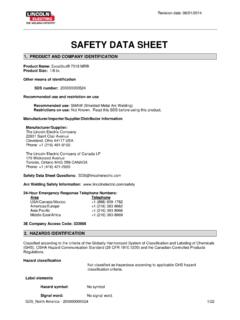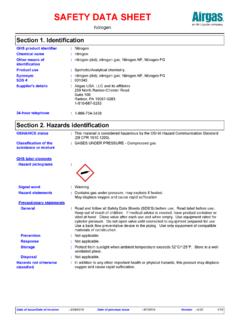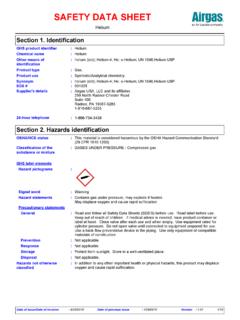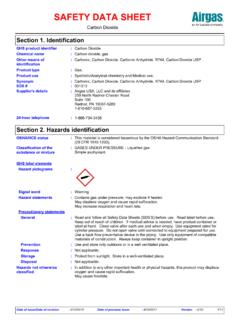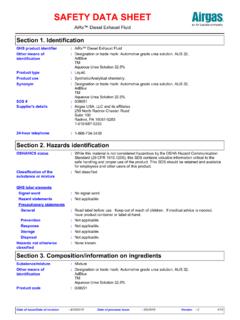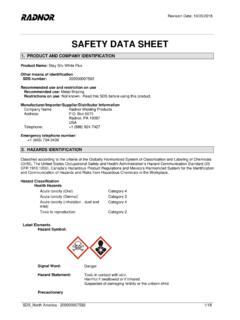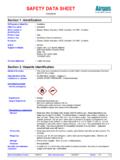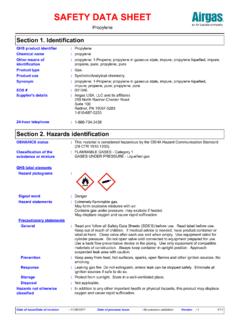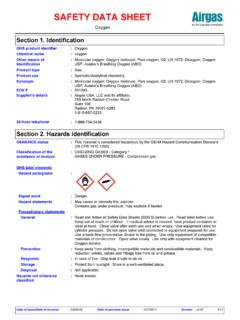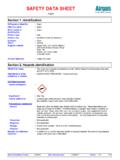Transcription of SAFETY DATA SHEET - Airgas
1 SAFETY data SHEET . hydrogen sulfide Section 1. Identification GHS product identifier : hydrogen sulfide Chemical name : hydrogen sulfide Other means of : hydrogen sulfide ; hydrogen sulfide (H2S); Sulfuretted hydrogen ; Sewer gas;. identification Hydrosulfuric acid; dihydrogen sulfide Product type : Gas. Product use : Synthetic/Analytical chemistry. Synonym : hydrogen sulfide ; hydrogen sulfide (H2S); Sulfuretted hydrogen ; Sewer gas;. Hydrosulfuric acid; dihydrogen sulfide SDS # : 001029. Supplier's details : Airgas USA, LLC and its affiliates 259 North Radnor-Chester Road Suite 100. Radnor, PA 19087-5283. 1-610-687-5253. 24-hour telephone : 1-866-734-3438. Section 2. Hazards identification OSHA/HCS status : This material is considered hazardous by the OSHA Hazard Communication Standard (29 CFR ). Classification of the : FLAMMABLE GASES - Category 1. substance or mixture GASES UNDER PRESSURE - Liquefied gas ACUTE TOXICITY (inhalation) - Category 2. SPECIFIC TARGET ORGAN TOXICITY (SINGLE EXPOSURE) (Respiratory tract irritation) - Category 3.
2 AQUATIC HAZARD (ACUTE) - Category 1. GHS label elements Hazard pictograms : Signal word : Danger Hazard statements : Extremely flammable gas. May form explosive mixtures with air. Contains gas under pressure; may explode if heated. Fatal if inhaled. May cause respiratory irritation. Very toxic to aquatic life. Extended exposure to gas reduces the ability to smell sulfides. Precautionary statements General : Read and follow all SAFETY data Sheets (SDS'S) before use. Read label before use. Keep out of reach of children. If medical advice is needed, have product container or label at hand. Close valve after each use and when empty. Use equipment rated for cylinder pressure. Do not open valve until connected to equipment prepared for use. Use a back flow preventative device in the piping. Use only equipment of compatible materials of construction. Always keep container in upright position. Do not depend on odor to detect presence of gas. Approach suspected leak area with caution.
3 Prevention : Wear respiratory protection. Keep away from heat, hot surfaces, sparks, open flames and other ignition sources. No smoking. Use only outdoors or in a well-ventilated area. Avoid release to the environment. Do not breathe gas. Date of issue/Date of revision : 11/30/2017 Date of previous issue : 3/23/2017 Version :1 1/12. hydrogen sulfide Section 2. Hazards identification Response : Collect spillage. IF INHALED: Remove person to fresh air and keep comfortable for breathing. Immediately call a POISON CENTER or physician. Leaking gas fire: Do not extinguish, unless leak can be stopped safely. Eliminate all ignition sources if safe to do so. Storage : Store locked up. Protect from sunlight. Store in a well-ventilated place. Disposal : Dispose of contents and container in accordance with all local, regional, national and international regulations. Hazards not otherwise : In addition to any other important health or physical hazards, this product may displace classified oxygen and cause rapid suffocation.
4 Section 3. Composition/information on ingredients Substance/mixture : Substance Chemical name : hydrogen sulfide Other means of : hydrogen sulfide ; hydrogen sulfide (H2S); Sulfuretted hydrogen ; Sewer gas;. identification Hydrosulfuric acid; dihydrogen sulfide Product code : 001029. CAS number/other identifiers CAS number : 7783-06-4. Ingredient name % CAS number hydrogen sulfide 100 7783-06-4. Any concentration shown as a range is to protect confidentiality or is due to batch variation. There are no additional ingredients present which, within the current knowledge of the supplier and in the concentrations applicable, are classified as hazardous to health or the environment and hence require reporting in this section. Occupational exposure limits, if available, are listed in Section 8. Section 4. First aid measures Description of necessary first aid measures Eye contact : Immediately flush eyes with plenty of water, occasionally lifting the upper and lower eyelids.
5 Check for and remove any contact lenses. Continue to rinse for at least 10. minutes. Get medical attention if irritation occurs. Inhalation : Get medical attention immediately. Call a poison center or physician. Remove victim to fresh air and keep at rest in a position comfortable for breathing. If it is suspected that fumes are still present, the rescuer should wear an appropriate mask or self-contained breathing apparatus. If not breathing, if breathing is irregular or if respiratory arrest occurs, provide artificial respiration or oxygen by trained personnel. It may be dangerous to the person providing aid to give mouth-to-mouth resuscitation. If unconscious, place in recovery position and get medical attention immediately. Maintain an open airway. Loosen tight clothing such as a collar, tie, belt or waistband. Skin contact : Flush contaminated skin with plenty of water. Remove contaminated clothing and shoes. To avoid the risk of static discharges and gas ignition, soak contaminated clothing thoroughly with water before removing it.
6 Get medical attention if symptoms occur. Wash clothing before reuse. Clean shoes thoroughly before reuse. Ingestion : As this product is a gas, refer to the inhalation section. Most important symptoms/effects, acute and delayed Potential acute health effects Eye contact : No known significant effects or critical hazards. Inhalation : Fatal if inhaled. May cause respiratory irritation. Skin contact : No known significant effects or critical hazards. Frostbite : Try to warm up the frozen tissues and seek medical attention. Ingestion : As this product is a gas, refer to the inhalation section. Date of issue/Date of revision : 11/30/2017 Date of previous issue : 3/23/2017 Version :1 2/12. hydrogen sulfide Section 4. First aid measures Over-exposure signs/symptoms Eye contact : No specific data . Inhalation : Adverse symptoms may include the following:, respiratory tract irritation, coughing Skin contact : No specific data . Ingestion : No specific data . Indication of immediate medical attention and special treatment needed, if necessary Notes to physician : Treat symptomatically.
7 Contact poison treatment specialist immediately if large quantities have been ingested or inhaled. Specific treatments : No specific treatment. Protection of first-aiders : No action shall be taken involving any personal risk or without suitable training. If it is suspected that fumes are still present, the rescuer should wear an appropriate mask or self-contained breathing apparatus. It may be dangerous to the person providing aid to give mouth-to-mouth resuscitation. See toxicological information (Section 11). Section 5. Fire-fighting measures Extinguishing media Suitable extinguishing : Use an extinguishing agent suitable for the surrounding fire. media Unsuitable extinguishing : None known. media Specific hazards arising : Contains gas under pressure. Extremely flammable gas. In a fire or if heated, a from the chemical pressure increase will occur and the container may burst, with the risk of a subsequent explosion. This material is very toxic to aquatic life.
8 Fire water contaminated with this material must be contained and prevented from being discharged to any waterway, sewer or drain. Hazardous thermal : Decomposition products may include the following materials: decomposition products sulfur oxides Special protective actions : Promptly isolate the scene by removing all persons from the vicinity of the incident if for fire-fighters there is a fire. No action shall be taken involving any personal risk or without suitable training. Contact supplier immediately for specialist advice. Move containers from fire area if this can be done without risk. Use water spray to keep fire-exposed containers cool. If involved in fire, shut off flow immediately if it can be done without risk. If this is impossible, withdraw from area and allow fire to burn. Fight fire from protected location or maximum possible distance. Eliminate all ignition sources if safe to do so. Special protective : Fire-fighters should wear appropriate protective equipment and self-contained breathing equipment for fire-fighters apparatus (SCBA) with a full face-piece operated in positive pressure mode.
9 Section 6. Accidental release measures Personal precautions, protective equipment and emergency procedures For non-emergency : Accidental releases pose a serious fire or explosion hazard. No action shall be taken personnel involving any personal risk or without suitable training. Evacuate surrounding areas. Keep unnecessary and unprotected personnel from entering. Shut off all ignition sources. No flares, smoking or flames in hazard area. Do not breathe gas. Provide adequate ventilation. Wear appropriate respirator when ventilation is inadequate. Put on appropriate personal protective equipment. For emergency responders : If specialized clothing is required to deal with the spillage, take note of any information in Section 8 on suitable and unsuitable materials. See also the information in "For non- emergency personnel". Date of issue/Date of revision : 11/30/2017 Date of previous issue : 3/23/2017 Version :1 3/12. hydrogen sulfide Section 6. Accidental release measures Environmental precautions : Ensure emergency procedures to deal with accidental gas releases are in place to avoid contamination of the environment.
10 Inform the relevant authorities if the product has caused environmental pollution (sewers, waterways, soil or air). Water polluting material. May be harmful to the environment if released in large quantities. Collect spillage. Methods and materials for containment and cleaning up Small spill : Immediately contact emergency personnel. Stop leak if without risk. Use spark-proof tools and explosion-proof equipment. Large spill : Immediately contact emergency personnel. Stop leak if without risk. Use spark-proof tools and explosion-proof equipment. Note: see Section 1 for emergency contact information and Section 13 for waste disposal. Section 7. Handling and storage Precautions for safe handling Protective measures : Put on appropriate personal protective equipment (see Section 8). Contains gas under pressure. Do not get in eyes or on skin or clothing. Use only with adequate ventilation. Wear appropriate respirator when ventilation is inadequate. Do not enter storage areas and confined spaces unless adequately ventilated.
